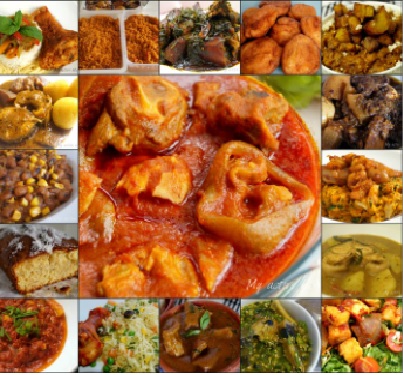With about 300 or more distinct ethnic groups and languages, Nigeria is the third most ethnically diverse country in Africa. And with this diversity comes an interesting array of Nigerian cuisine – as diverse as the ethnic origins of the Nigerian people. We intend to unveil the favors of Nigeria, in order to stimulate your taste buds. If you are an investor, tourist, or foreigner hoping to spend some time on Nigerian soil, this is an excellent intro for you. By all means, you need to sample some of these exquisite dishes that are hallmarks of the flavors of Nigeria. You will never forget the pleasant experience. We will make a brief journey across Nigeria’s different regions and the tribes that occupy them in this article. The unique and varied combination of colors, spices, staples, ingredients and dishes associated with each region is worth exploring.
Northern Nigeria: The Home of Cereals
Northern Nigeria is characteristically occupied by a number of ethnic groups who dwell in arid (and semi-arid) lands, as well as savanna vegetation. This environment favors the cultivation of cereals, pulses and vegetables, cattle rearing (cows, sheep and goats inclusive) as well as guinea fowl. As such, one should expect to find such staples as rice, corn, groundnut, sorghum, millet, beans, dairy milk, and meat dishes.
A good variety of vegetables and spices are also available. Okro, tomato, pepper, spinach, onions, garlic, ginger, cumin, cloves and many other veggies and spices are quite common. The largest ethnic groups that occupy this region are the Hausa, Fulani and Kanuri tribes.
Prepare yourself to taste the flavors of Nigeria in an assortment of Northern foods which include the following:
- Tuwo: A steamed, starchy swallow meal made from either rice (tuwo shinkafa), maize/corn (tuwo masara) or sorghum (tuwo dawa). Tuwo is often served with spicy soups (‘miyan’). Such soups include pumpkin soup (miyan taushe), baobab leaf soup (miyan kuka), and spinach soup (miyan zogale). Groundnut soup is also common.
- Masa: Moulded rice cakes
- Iconic meat snacks. These include ‘suya’ – grilled beef filets served with special spice and chopped, raw vegetables. There is also ‘kilishi’ which is roasted, spicy dried meat.
- Groundnut snacks. These include ‘kulikuli’ (ground, fried and dried groundnut crunchies) and ‘dankwa’ (energy balls).
- Fura de nunu. This is a millet dough ball spiced with ginger, cloves and sometimes pepper. It is normally served with cow milk.
- Dried/smoked fish is also quite common – notably catfish, and other kinds of smoked fish (‘mangala’).
Southeast Nigeria: A Harvest of Tubers, Herbs, Spices and Rich Vegetables
The Igbo ethnic group of southeast Nigeria will surely not disappoint you when it comes to a feast of the flavors of Nigeria. Their recipes are quite tasty. Igbo people dwell in the forest regions, and therefore grow an abundance of dense tuber foods and grains. These include yam, cocoyam, cassava, maize, plantain, African breadfruit (‘ukwa’), beans, and bambara nuts (‘okpa’). Cassava meal (‘akpu/fufu’), cornmeal (‘agidi’) and pounded yam/plantain are common staples amongst the Igbos. Palm oil is also used in plenty to cook Igbo foods.
They have so many fruits and vegetables. ‘Ukazi’, ‘Uziza’, ‘Utazi’, ‘Oha’, fluted pumpkin (‘ugwu’), bitter leaf (‘onugbu’), water leaf, basil, spring onions, melon seed (‘egusi’), and mango seed (‘ogbono’) are typical vegetables in Igboland. While a wide array of herbs and spices are commonly incorporated into their stews. The iconic oil bean seed (‘ugba/ukpaka’) and ‘ogiri’ are commonly used for seasoning. They typically eat less red peppers; and favor the use of cameroon (yellow) pepper.
Expect to enjoy well-seasoned and spicy foods in the southeast Nigeria which include the following:
- Abacha: A traditional salad made from shredded and dried cassava, served with raw onions, palm oil, ‘ugba’, chopped ‘ugwu’ leaves and other ingredients.
- Nkwobi (Spicy cow feet’): Made from cow foot, palm oil, spices, pepper, onions, crayfish, ‘utazi’ leaves, and calabash nutmeg (‘ehu’).
- Isi Ewu (‘Goat head’): Cooked goat head in palm oil, ‘ehu’ seeds, ‘utazi’ leaves, pepper, onions, spices, and seasoning.
- Ukwa (Breadfruit porridge): A porridge made from the African breadfruit. Dried fish, crayfish, ‘ugwu’ leaves and palm oil are the typical additives.
- Various rich soups and stews known as ‘ofe’. These include ‘ofe onugbu’, ‘ofe oha’, ‘ofe egusi’, ‘ofe akwu’, ‘ofe Owerri’, ‘ofe Nsala’, ‘ofe Ukazi’ and ‘ofe Ede’, to mention a few. A mix of fresh and/or dried meat, fish, crayfish, periwinkles, and cowhide are commonly incorporated into these soups and stews.
Southwest Nigeria: Tubers, Vegetables, Herbs and Spices Galore
The Yoruba people of southwest Nigeria do not hide their love for colorful, rich and well-seasoned food. They have these in abundant variety. Vegetable stews served with quality protein are a typical part of Yoruba cuisine. The likes of cow hide (’ponmo’), beef, sheep and goat meat, seafoods, as well as poultry in exciting combinations are on offer. And – they definitely do not joke with the iconic pepper!
The prime location of Yorubaland in the rainforests and coastal regions favor the cultivation of dense carbohydrate foods. Tubers – cocoyam, yam, cassava, potato are cultivated in abundance. Also maize, local rice (‘ofada’), many fruits and vegetables, herbs and spices are quite common.
Expect to find tasty local delicacies such as the following:
- Iyan (pounded yam/cocoyam): This is steamed yam (or cocoyam) pounded into a semi-solid form, and eaten in morsels. It is usually served with a rich vegetable stew.
- Amala (Steamed yam, cassava or unripe plantain flour). A fluffy semi-solid meal served with any vegetable stew. However, the iconic bean soup (‘gbegiri’) mixed with jute stew (‘ewedu’) are the most common accompaniment.
- Adalu (Corn and Beans Stew): A simple but rich meal of boiled corn and beans, cooked until soft. Palm oil, salt, shrimps/prawns, pepper, onions are normally added. Perhaps animal protein such as dried fish and/or meat may be thrown into the mix.
- Asaro (Yam, potato or Plantain Porridge): This rich meal is prepared by cooking either yam, unripe plantain or potato in water until soft. Optionally some beans may be boiled with it. It may be served with pepper stew and/or vegetables, and fried plantain.
- Moin-Moin and Akara: Both of them are prepared from peeled and blended beans. Moin-moin is steamed bean pudding; while Akara is fried bean cakes. Aside from their distinct methods of preparation, both of them have practically the same basic ingredients. These include beans, pepper, onions, palm oil, seasoning and salt. Optional ingredients may include ginger and garlic, boiled eggs, fish, minced meat, shrimps/prawns and vegetables.
- Eba (Steamed cassava pudding): This semi-solid food is prepared from steamed cassava flakes (‘garri’). It is also served with any rich stew.
- Vegetable stews and soups (‘obe’) are in abundance. They include pepper stew (‘obe ata’), melon soup (‘obe egusi’), spinach stew (‘efo-riro’), okro soup (‘obe ila’), bitter leaf stew (‘obe ewuro’), jute soup (‘obe ewedu’) and mango seed soup (‘obe apon’).
- Jollof rice: A one-pot rice dish made by cooking rice in a mix of blended pepper, onions, tomatoes, and several spices. It is commonly served with fried ripe plantain (‘dodo’), fried meat, fish and/or boiled eggs. Though the dish is typically a West African dish which originated outside Nigeria, it is now so commonly consumed in southwest Nigeria. It has even attained the status of an official party meal in many parts of Nigeria.
South-South Nigeria: The Heaven of Seafoods (and Yet More Spices)
The coastal towns and cities of the Niger Delta, Lagos, Ondo, Akwa Ibom, Rivers and Cross River states will wow you with fresh seafood. Here, the Urhobo, Itsekiri, Ijaw, Kalabari, Ibibio, Efik and neighboring ethnic groups thrive and fish regularly. Shrimp, prawns, crayfish, catfish, various other species of fish, crabs, periwinkles and other shelled fish are found in abundance in these regions. Spices are also widely used for cooking. Plantains and yam are quite common.
Typical delicacies in these regions include the iconic pepper soup, fisherman’s soup, the vegetable-rich ‘edikang-ikong’ soup, and roasted plantain (‘bole’) and fish.







